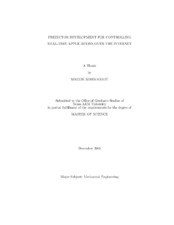| dc.description.abstract | Over the past decade there has been a growing demand for interactive multimedia
applications deployed over public IP networks. To achieve acceptable Quality of Ser-
vice (QoS) without significantly modifying the existing infrastructure, the end-to-end
applications need to optimize their behavior and adapt according to network char-
acteristics. Most existing application optimization techniques are based on reactive
strategies, i.e. reacting to occurrences of congestion. We propose the use of predic-
tive control to address the problem in an anticipatory manner. This research deals
with developing models to predict end-to-end single flow characteristics of Wide Area
Networks (WANs).
A novel signal, in the form of single flow packet accumulation, is proposed for
feedback purposes. This thesis presents a variety of effective predictors for the above
signal using Auto-Regressive (AR) models, Radial Basis Functions (RBF) and Sparse
Basis Functions (SBF). The study consists of three sections. We first develop time-
series models to predict the accumulation signal. Since encoder bit-rate is the most
logical and generic control input, a statistical analysis is conducted to analyze the
effect of input bit-rate on end-to-end delay and the accumulation signal. Finally,
models are developed using this bit-rate as an input to predict the resulting accu-
mulation signal. The predictors are evaluated based on Noise-to-Signal Ratio (NSR)
along with their accuracy with increasing accumulation levels. In time-series models, RBF gave the best NSR closely followed by AR models. Analysis based on accu-
racy with increasing accumulation levels showed AR to be better in some cases. The
study on effect of bit-rate revealed that bit-rate may not be a good control input on
all paths. Models such as Auto-Regressive with Exogenous input (ARX) and RBF
were used to develop models to predict the accumulation signal using bit-rate as a
modeling input. ARX and RBF models were found to give comparable accuracy, with
RBF being slightly better. | en |


